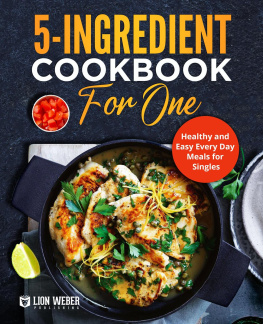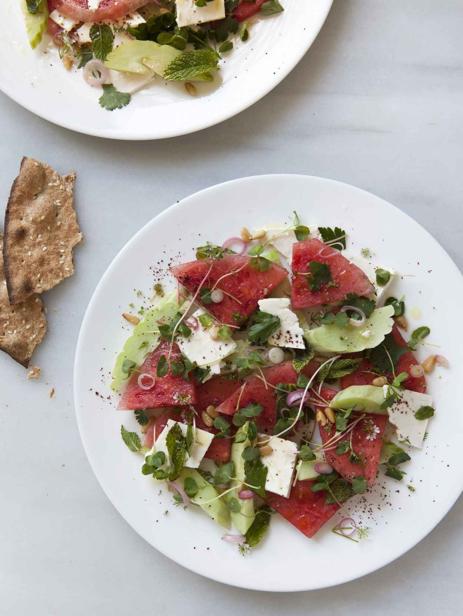ONE INGREDIENT CAN CHANGE THE NATURE OF A DISH, ELEVATING IT FROM FLAT TO TRANSCENDENT.
Do you have a kitchen full of jars and pastes and flours you want to use more? From capers, crme frache, and fish sauce to date syrup, labneh, preserved lemon, and more, Michelle McKenzie offers a fresh perspective on magical pantry items that are often overlooked by home cooks.
With 58 ingredient profiles and more than 260 recipes and variations featuring those ingredients, learn to harness the power of your pantry to make dishes extraordinary. Undeniably inspiring yet also happily pragmatic, The Modern Larder will change your approach to cooking and elevate your everyday meals.
The Modern Larder is a thoughtful study of the most oft-neglected space in our kitchens: the pantry. Michelle provides a treatise on stocking your shelves with consideration and then invites home cooks to enjoy the gratifying practice of utilizing those ingredients in everyday cookingfor example, the Fried Shishitos with Dancing Bonito lives up to the poetry of its name. Both useful and inspirational, this book feels made for this moment.
Tara OBrady,
author of Seven Spoons
Michelle McKenzies new book delights in the everyday celebration of diverse cultural flavors, beauty, and deliciousness. Her recipes are lucid and encourage exploration. I was thrilled to find more than a dozen Japanese ingredients in the pages of The Modern Larder, including bonito flakes, miso, shio koji, and umeboshi, along with useful tips for incorporating these flavors into your everyday cooking. This book, enhanced by Rick Poons breathtaking photography, is definitely one that I will return to again and again.
Sonoko Sakai,
author of Japanese Home Cooking
Its no surprise that Michelle McKenzie has applied her considerable smarts to this brilliant, beautiful tome. Minimalist and deeply alluring at once, The Modern Larder is the kind of book I will not only proudly display like art, but dip into again and again for inspiration, wisdom, and recipes so good I want to make every one.
Sarah Copeland, author of
Every Day Is Saturday, Feast, and Instant Family Meals
lar der | \lr-dr
The area in the house used for storing food. This includes pantries, refrigerators, cupboards, and any other areas that hold culinary ingredients such as dry legumes, nuts and seeds, cultured dairy, canned goods, pickles, ferments, spice blends, cured meats, preserved fish, and grains both whole and milled.
Roost Books
An imprint of Shambhala Publications, Inc.
2129 13th Street
Boulder, CO 80302
roostbooks.com
2021 by Michelle McKenzie
Photographs 2021
by Rick Poon
Cover art: Kara Plikaitis
All rights reserved. No part of this book may be reproduced in any form or by any means, electronic or mechanical, including photocopying, recording, or by any information storage and retrieval system, without permission in writing from the publisher.
For more information please visit www.shambhala.com.
Roost Books is distributed worldwide by Penguin Random House, Inc., and its subsidiaries.
Library of Congress Cataloging-in-Publication Data
Names: McKenzie, Michelle, 1983 author. | Poon, Rick, photographer.
Title: The modern larder / Michelle McKenzie; photographs by Rick Poon.
Description: First edition. | Boulder, Colorado: Roost Books, [2021] | Includes bibliographical references.
Identifiers: LCCN 2020011082 | ISBN 9781611805703 (hardback)
eISBN 9780834844001
Subjects: LCSH: Quick and easy cooking. | Cooking, American. | LCGFT: Cookbooks.
Classification: LCC TX833.5 .M445 2021 | DDC 641.5/12dc23
LC record available at https://lccn.loc.gov/2020011082
a_prh_5.8.0_c0_r1
For Mike and Luke
whose hearts and bellies
inspire me every day
CONTENTS

INTRODUCTION
What Is the Modern Larder?
Before my son was born, most of my waking hours were spent shopping for, prepping, and cooking food. It was my job, my pleasure, the way I cared for and connected with others. My first cookbook, Dandelion & Quince, reflected this passion. In it I set about showcasing all the unusual produceremarkable fruits, vegetables, and herbsthat are increasingly accessible but often overlooked by the everyday shopper. On every page I aimed to compel readers to take risks with new foods and techniques. It was invigorating, a teaching high. And then, halfway through the writing, I realized I had a parallel story to tell about my larderthe oils, vinegars, sauces, syrups, spices, and preserves I rely on every day. Items such as capers, crme frache, miso, shio koji, preserved lemons, date syrup, fish sauce, rice flour, ghee, yuzu, and so on.
This was a larder Id been expanding most of my adult life. But when I spoke to culinary students and friends about it, they blanched. Michelle, I wouldnt know what to do with chickpea flour or kefir, they said. Their reactions convinced me I was on to something, specifically cookbook number two. For my students, friends, and readers, I would take each of my larder favorites and give it a 360-degree treatment. For example, Id show readers how shio koji can be used as a dressing, a marinade (that transforms meat and fish), a pickling medium, or simply liquid supersalt.
Then I had that baby boy I mentioned. Everyone told me hed change everything. He did. Now, the constraints of motherhood have shown me another reason why this cookbook is needed: mining the larder is the ultimate efficiency. It saves time. It saves my family every day.
I revere the traditional French and Italian approach of bottom-up cooking: an initial sear of meats and sweating down of vegetables; the subsequent deglazing of the pan; careful tending. These methods create fully developed flavor and provide a dependable foundation on which to build a dish. While cooking remains a redemptive pleasure and I look forward to my time in the kitchen, nowadays Im prone to bypassing a lengthy building process and instead employ hardworking ingredients from my larder. I saut in umami-rich schmaltz, toss dried limes into simmering beans, shower homemade spice blends on roasted vegetables, bake with cultured dairy and charismatic flours, and spike many things with fish sauce. In this way, I get maximum impact for minimal effort.
By offering you a fresh and freeing perspective on some powerful ingredients while arming you with pro tips and solid techniques, I aim to loosen up the cook in you. Instead of big weekend or monthlong projects like preserving lemons, infusing vinegar, or making jam, I have spent my ink on less intimidating matters, demystifying kitchen keystones from a cross section of cultures and influences, and showing that theres no authentic or inauthentic usageif a combination makes sense to the palate, its right. I dispose of sacrilege entirely (I braise my holiday brisket with mole spices, mix fish sauce with olive oil, and pair miso with dill) and encourage you to use everything at your disposalbecause when you do, magic is made. These recipe ideas are meant to free you from monotony and guide you in finessing already fine ingredients into inspired versions of themselves.
If The Modern Larder came with a thesis, it would be: one ingredient can change the nature of a dish, elevating it from flat to transcendent. Many of the featured ingredients are those secret somethings in the dishes at your favorite restaurants. Some have recently becomeor are likely to becomemainstream in American food culture and available to all home cooks. Most can be easily found online or, especially if youre near a big city, at a brick-and-mortar. This list is certainly not exhaustive, but it contains the ingredients I find the most compelling, those that have most changed and improved my cooking.













